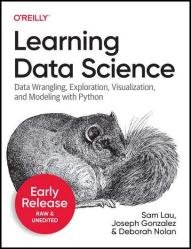 Название: Learning Data Science: Programming and Statistics Fundamentals Using Python (Sixth Early Release)
Название: Learning Data Science: Programming and Statistics Fundamentals Using Python (Sixth Early Release)Автор: Sam Lau, Deborah Nolan, Joseph Gonzalez
Издательство: O’Reilly Media, Inc.
Год: 2023-03-23
Страниц: 434
Язык: английский
Формат: epub (true), mobi
Размер: 15.0 MB
As an aspiring data scientist, you appreciate why organizations rely on data for important decisions--whether it's for companies designing websites, cities deciding how to improve services, or scientists discovering how to stop the spread of disease. And you want the skills required to distill a messy pile of data into actionable insights. We call this the Data Science lifecycle: the process of collecting, wrangling, analyzing, and drawing conclusions from data.
Learning Data Science is the first book to cover foundational skills in both programming and statistics that encompass this entire lifecycle. It's aimed at those who wish to become data scientists or who already work with data scientists, and at data analysts who wish to cross the "technical/nontechnical" divide. If you have a basic knowledge of Python programming, you'll learn how to work with data using industry-standard tools like Pandas.
This book covers fundamental principles and skills that data scientists need to help make all sorts of important decisions. With both technical skills and conceptual understanding we can work on data-centric problems to, say, assess whether a vaccine works, filter out fake news automatically, calibrate air quality sensors, and advise analysts on policy changes. To help you keep track of the bigger picture, we’ve organized topics around a workflow that we call the data science lifecycle. In this chapter, we introduce this lifecycle. Unlike other data science books that tend to focus on one part of the lifecycle or address only computational or statistical topics, we cover the entire cycle from start to finish and consider both statistical and computational aspects together.
Data scientists work with data stored in tables. The Chapter 3 introduces dataframes, one of the most widely used ways to represent data tables. We’ll also introduce Pandas, the standard Python package for working with dataframes. Data types in a programming sense refers to how a computer stores data internally. For instance, the size column has a string data type in Python. But from a statistical point of view, the size column stores ordered categorical data (ordinal data). We talk more about this specific distinction in the next chapter. In this chapter, we’ll show you how to do common dataframe operations using pandas. Data scientists use the Pandas library when working with dataframes in Python. First, we’ll explain the main objects that pandas provides: the DataFrame and Series classes. Then, we’ll show you how to use pandas to perform common data manipulation tasks, like slicing, filtering, sorting, grouping, and joining.
Refine a question of interest to one that can be studied with data
Pursue data collection that may involve text processing, web scraping, etc.
Glean valuable insights about data through data cleaning, exploration, and visualization
Learn how to use modeling to describe the data
Generalize findings beyond the data
Скачать Learning Data Science (Sixth Early Release)